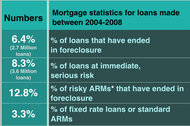Payday loans and deposit-advance loans are intended to be short-term options for emergency cash, but they can turn into long-term debt traps for borrowers, a new federal report says.
The Consumer Financial Protection Bureau, which prepared the report, found that the short-term, high-interest-rate loans are too often made without regard to a borrower’s ability to repay them. As a result, borrowers get in over their heads and have to extend the loans repeatedly, incurring more fees. Two-thirds of payday borrowers, the report found, had seven more loans in a year.
Payday loans are typically made at storefront locations and secured by a paycheck, while deposit advance loans are currently made by a handful of big banks, and are repaid out of an anticipated electronic deposit into a checking account. Borrowers use the loans the same way, the report found.
The New York Times reported Wednesday that federal bank regulators, including the Office of the Comptroller of the Currency and the Federal Deposit Insurance Corporation, are expected to clamp down this week on big banks’ offerings of deposit advance loans, setting new rules to protect borrowers.
“For too many consumers, payday and deposit advance loans are debt traps that cause them to be living their lives off money borrowed at huge interest rates,” Richard Cordray, the Consumer Financial Protection Bureau’s director, said in a conference call with reporters.
Have you ever taken out either of these types of loans? What was your experience?
The report joins research from other groups, like the Center for Responsible Lending and the Pew Charitable Trusts, in raising concerns about the loans. The bureau said its report looked at more than 15 million payday loans from storefront lenders and “multiple” banks that make deposit advances, and is one of the most comprehensive done on the subject. Officials declined, however, to say how many lenders and banks participated in the report.
The loans typically carry high fees. Fees for payday loans range from $10 to $20 per $100 borrowed. So for a typical loan of $350, the median fee of $15 per $100 would mean the borrower must come up with more than $400 in two weeks. (Such a loan would carry an annual percentage rate of 391 percent).
Deposit advances are somewhat less costly, at about $10 per $100 borrowed. A $100 loan made for 12 days would carry an A.P.R. of 304 percent.
The report cited as a main concern the “sustained use” of the loans by borrowers who repeatedly take out the loans in rapid sequence — often on the same day as the previous loan is repaid, in the case of payday loans. Similarly, the average deposit advance user has breaks of less than two weeks between borrowing “spells,” the bureau found.
“As a result,” the bureau noted, “many borrowers incur significant costs over time.”
The report said the bureau would analyze the effectiveness of “cooling-off periods” between loans as a way to reduce the harm from sustained use of the loans.
The report did not include new online lenders that are making similar short-term loans, but the bureau said it is analyzing such loans separately.
If you have ever used a payday loan or an advance deposit loan, would being forced to wait between loans help you manage the debt?
Article source: http://bucks.blogs.nytimes.com/2013/04/24/short-term-payday-loans-can-become-long-term-traps/?partner=rss&emc=rss
